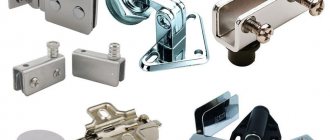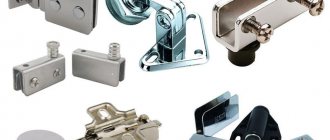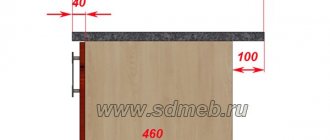/Household appliances/Built-in/
Purchasing a dishwasher is justified for a number of reasons. It consumes 3-5 times less water compared to regular dishwashing, copes with this task much better and saves your time. The dimensions of the dishwasher are one of the main selection criteria, especially if you want to buy a built-in or partially built-in model. Let's find out what dimensions different types of machines have, and what sizes will be optimal for your kitchen and family.
What are the sizes of PMM?
The first dishwasher appeared 150 years ago. During this time, it was transformed into a compact device that replaced human labor. Or rather, the most routine part of it is washing dishes. The dimensions of dishwashers (hereinafter referred to as DMM) are not just a standard or a whim of the manufacturer, but an optimal solution found through experience and many years of testing.
The machines offered on the market have different installation methods, functionality, chamber volume, water consumption, washing class... But the first thing buyers pay attention to is the dimensions. All offered devices are divided into three categories; let’s look at each in more detail.
Full size
These are the most common standard cars for a large family. Their minimum dimensions:
- height - 85 cm;
- width - 60 cm;
- depth - 60 cm.
The set of dishes in which the capacity of the PMM is measured includes a set of dishes for a single meal - 3 plates of different sizes (for soup, main course and salad), a cup and saucer, a glass, 2 spoons, a fork, and a knife. U may vary slightly.
Full-size models are chosen for spacious kitchens. Such devices can handle any volume of dishes. They will help out on days of feasts and celebrations. Designed for at least 12 sets. They come in two types:
- Standing separately. Free-standing devices have a drawback - they take up free space and can be dissonant with the interior. This is why built-in appliances are in great demand today. Consumers prefer to hide the PMM under the sink or build it into furniture.
It is beneficial when a full-size model has a half-load mode. You don't always have to wash a lot of dishes. And thanks to this mode, you can save on water and detergent.
- Built-in. These models are designed for installation in a closet. The machine is selected in accordance with the existing dimensions of the niche. If the furniture is made to order, the choice is simplified. The façade is designed to look like furniture—the machine is either completely hidden, or only its control panel is visible. In the latter case, the machine is called partially built-in. Built-in models are an ideal solution for a kitchen where every centimeter is accounted for.
Narrow
These models differ from their full-size counterparts in their width. For a narrow machine, it is 45 cm. These machines, like full-size ones, can be free-standing or built-in. The installation dimensions of the machine must correspond to the size of the box into which the PMM is to be built. Narrow models are inferior in chamber volume to full-sized versions; they can accommodate approximately 10 dish sets - this is more than enough for an average family of 3-4 people.
A narrow built-in machine is the most popular PMM option among consumers. They are cheaper and more compact than full-size ones, take up minimal space in the kitchen and at the same time are able to wash all the dishes - from glasses to pans.
Compact
The dimensions of the small, or compact, PMM allow it to be installed in the most cramped kitchen. Approximate dimensions:
- height of devices - from 40 cm;
- width - 45 cm;
- depth - from 40 cm.
Small-sized dishwashers are designed for a family of 2 people. These devices have minimal functions. The main advantage is compactness. There are two options for mini-PMM:
- Freestanding. Such devices can easily be placed on a table; they look similar to microwave ovens. The desktop mini-versions have no other advantages. They are limited in functionality and cannot wash large dishes - pots, baking trays, frying pans. You can only wash what will fit in it.
- Built-in. These models are installed in niches and cabinets. They, like the freestanding versions, can wash no more than 5-6 sets of dishes at a time. However, this is quite enough for people who are not keen on cooking.
Some kitchens are so cramped that their owners want to buy the narrowest possible machine - for example, 30 cm wide. But, firstly, there are no such devices on the market, and secondly, what will fit in the camera of such a baby? Today, the narrowest devices are 45 cm wide.
Connection via sink siphon and faucet.
You only need to change two things:
standard siphon under the sink to a special one
It differs in that its design already has a place for connecting the drain hose - a fitting, and sometimes two.
You can, of course, redo the sewer drain by installing an additional pipe and seal there.
The whole thing is inserted by hand, without using any special tools.
However, do not forget that connecting dishwashers and washing machines directly to the sewer pipe may be accompanied by the appearance of unpleasant odors.
Experts advise making this connection through a check valve.
Kinking or bending the hose at a height, which should act as an alternative to the valve, only helps with constant use of the equipment. Of course, your water will not return.
However, if the system stands for a couple of weeks without work and water (for example, in a country house or in a country house), everything will dry out and the stench in the kitchen will be very sensitive.
the second thing you need to install is a tee with a ¾-inch thread
Through it, the water itself will flow into the machine. It is installed instead of the standard connector that goes from cold water to the mixer.
Screw this tee to the cold water supply hose or pipe.
Next, change the siphon. Unscrew the screw from above, holding the siphon itself from below so that it does not fall.
Disconnect the drain from the sewer. To do this, simply pull it towards you with force. It should come out of the rubber retainer.
Assemble a new siphon from the components, not forgetting the gaskets, and install it in place of the old one.
Connect the flexible drain pipe to the sewer pipe. All that remains is to connect the dishwasher drain hose to the siphon tube through a special adapter.
Included with this adapter, be sure to look for a valve, it blocks the reverse flow of water.
Fill the sink with water and check that there are no leaks anywhere.
Which size is better?
Brands such as Bosch, Candy, Siemens, Ariston, Electrolux, Hansa, focusing on the Russian consumer , produce standard devices that are ideal for integration into kitchen furniture. But the manufacturers of prestigious equipment - Kuppersbusch, Miele, Smeg - are not so attentive to our consumers; the dimensions of their equipment can differ significantly from the standards. Before choosing a dishwasher, consider:
- Capacity needs. How many people are in the family, how often do you wash dishes, in what volumes - the choice depends on this.
- Kitchen dimensions. Is it possible to allocate space for a free-standing model or is a built-in option preferable to save space?
- Price. Narrow modifications are noticeably cheaper than full-size ones, and the most budget-friendly ones are compact cars.
Having decided on all three points, you can choose a technique that suits you in all respects.
This is important to know!
- The dishwasher is built into a modern standard element of the furniture set.
- If the furnishings in the kitchen are modern, there should be no difficulties with installing a dishwasher in the cabinet. The new cabinets are adapted to modern household appliances, so you can install a dishwasher without any problems.
It is important to follow the sequence exactly as prescribed in the instructions. You need to prepare the tools and materials needed for installation only after you have managed to plan where and how you will place the dishwasher, and how you will connect hoses and electrical communications to it
You need to prepare the tools and materials needed for installation only after you have managed to plan where and how you will place the dishwasher, and how you will connect hoses and electrical communications to it.
There may not be ready-made alternatives for installing a dishwasher. Therefore, you should work with a hammer, hacksaw or other tools, adjusting the existing cabinet to the parameters of the washing machine. Or you can make a brand new dishwasher cabinet with your own hands.
The whole process begins with preparatory work.
In addition to tools, you also need some materials, the list of which will also depend on the specific situation.
The following aspects of installation must be considered;
- take care of grounding;
- It is prohibited to place the device near the hob;
- you need to put a safety iron plate under the table top.
Manufacturers recommend sticking a metallized protective film to the back of the countertop before installing the device.
If you are concerned about the safety of the household appliances in your kitchen, you need to add a stabilizer to this list.
Before finally installing the dishwasher, you must:
- measure the installation section again (this is done to make sure that the dishwasher body fits freely with the section);
- check the gaps between the walls of the cabinet and dishwasher;
- Having removed the back wall in the cabinet, you should find out how spacious the area for wiring and hoses is;
- check the presence of the safety plate under the tabletop;
- insert the device block body into the section;
- level the device.
And one more thing - it is best to tighten the adjustable legs of the machine so that the unit lowers to the end, that is, to the floor.
If your kitchen does not have a normal outlet for connecting a dishwasher, you will have to make one.
In principle, the answer to the question of how to build a dishwasher into a finished kitchen with your own hands is practically given.
We connect the output wires to the machine, and then to the contacts of the socket; we enclose the wire in a plastic cable channel.
After completing installation, you should test the operation of the unit at idle. Once you are sure that the mechanism is working properly, you can safely show the work to friends and acquaintances, because installing a dishwasher in a cabinet yourself is something only a real man can do.
There are still some small nuances related to the connection.
And you don’t have to wait for repairs to install such a device.
How to install a dishwasher?
Regardless of the dimensions of the dishwashers, it is important to follow the rules when performing installation work:
- In advance - before purchasing a dishwasher - prepare a place for its installation. Measure the dimensions of the niche, cabinet, and free space.
- When choosing an installation location, consider the length of the hose - it should not be more than 1.5 m.
- The device must not be placed near batteries or heating devices.
- The outlet to which the PMM will be connected must be grounded.
- When purchasing, check the dimensions on the price tag with those indicated by the manufacturer in the documentation - errors are possible. In stores they may simply confuse something and you will have to change the device. It happens that stores round up the overall dimensions, cutting off a few millimeters, but they can be the reason that the device will not fit into the allotted space.
Furniture requirements for installing a dishwasher
Experts recommend equipping a kitchen, starting with choosing appliances, and then ordering cabinets, cabinets, and countertops to suit its dimensions.
If this option is not possible, you need to measure the height, width and depth of the future location as accurately as possible:
- the gap between the walls of the niche and the machine must be at least 5 mm;
- there should be free space in front of the niche to open the door;
- it is necessary to take into account the thickness and shape of the decorative panel on the facade;
- If a podium or plinth is provided, it must be able to easily support the weight of the device.
Built-in dishwashers may have adjustable legs that allow you to change their height. They are also equipped with special fasteners for embedding, handles, frames and other decorative elements.
Review of popular PMMs - full-size, narrow and compact
Let's see which dishwashers, belonging to different size categories, are in the greatest demand among buyers according to Yandex.Market.
Bosch Serie 2 SMV24AX02R
A regular white dishwasher with a display and electronic controls. Energy consumption per cycle is 1.05 kW/h. The washing duration on the standard program is 210 minutes. Noise - 52 dB. Drying type: condensation. In addition to standard programs, there are special ones - delicate and economical mode. There is no clean water sensor or automatic hardness detection. Weight - 30 kg. Specifications:
| Type | full size |
| Installation | fully built-in |
| Capacity, sets | 12 |
| Energy consumption | A |
| Washing/drying | A/A |
| Water consumption per cycle, l | 11,7 |
| Dimensions (WxDxH), cm | 59.8x55x81.5 |
| Programs, pcs. | 4 |
| Approximate cost, rubles | 25 400 |
Advantages:
- there is a 50% load;
- timer - 3–9 hours;
- you can use “3 in 1” tablets;
- high quality washing;
- beam on the floor;
- complete protection against leaks.
Flaws:
- the manufacturer did not provide child protection;
- increased noise;
- insufficiently clear instructions;
- short hoses - have to be extended;
- no knife tray.
The main disadvantage of this model is that it is not quiet enough. But most consumers are ready to forgive this drawback - the device copes with its duties perfectly and at the same time has an affordable price.
Indesit DISR 16B
Narrow PMM from Indesit. Electronically controlled, but without display. Energy consumption - 0.83 kW/h per cycle. Washing time with the standard program is 180 minutes. Noise - 51 dB. Drying type: condensation. There is soaking, delicate and economy programs. Weighs 31.5 kg. Technical specifications:
| Type | narrow |
| Installation | fully built-in |
| Capacity, sets | 10 |
| Energy consumption | A |
| Washing/drying | A/A |
| Water consumption per cycle, l | 10 |
| Dimensions (WxDxH), cm | 44x55x82 |
| Programs, pcs. | 6 |
| Approximate cost, rubles | 16 450 |
Advantages:
- simple controls;
- affordable price;
- low noise level;
- many useful programs;
- high-quality drying.
Flaws:
- poor quality washing on the eco program;
- no half load.
Installation tips and tricks
It is recommended to install the dishwashing device at a distance of no more than one and a half meters from the drain point. Otherwise, the likelihood of problems with the drain hose will increase and its effectiveness will decrease. In everyday life, the best installation option is considered to be a place next to the sink. When installing on the floor, it is important to ensure reliable contact with the surface. Water supply, in turn, is best done with a separate pump, with additional cleaning means. If you ignore this precaution, microparticles and rust from the water supply will damage the machine long before the maximum service life has expired. The drain point is prepared in advance. It is advisable to arrange a direct drain into the sewer. Installing stationary PMMs is not as difficult as it seems, but it is important not to damage the wires and furniture partitions.
You should buy machines with a leak protection system. For example, with one of these:
- AquaStop;
- Waterproof;
- Aqua-Control;
- AquaAlarm.
conclusions
User opinions may differ regarding certain models of built-in dishwashers. Some people make excessive demands from the very beginning. Someone has something to compare certain purchases with. The most positive aspects are noted by those for whom a car is the first purchase in life. Equally important is what conditions are met when installing and operating a built-in dishwasher.
There are a large number of dishwashers on the market up to 60 centimeters wide.
Recently, buyers have been paying a lot of attention to additional and basic functions, including dishwasher drying. The number of supported programs for a built-in dishwasher determines how much the device will cost. Therefore, it is necessary from the very beginning to determine the needs and acceptable level of spending. Installation costs and further maintenance of the built-in dishwasher are taken into account. It is important to pay attention to the detergents used. The more choice, the better.
Installation of new pipes
For major installation you will need a varied range of materials:
polypropylene pipe PPR PN20 with a diameter of 20mm
water socket
union nut connectors
90 degree connection fitting PPR-90
HP/HP elbow with ¾" external thread
FUM sealing tape
When installing pipes, the socket method is used. To do this, you will need a special apparatus for soldering polypropylene pipes.
The total length of the pipe and the number of fittings are selected individually. This depends on how far the dishwasher is from the cold water collector.
To begin with, mark the route where the pipes will be laid from the distribution manifold to the installation site of the PMM.
Then, use a wall chaser to cut to the required depth.
Next, connect the PPR connectors with a union nut to one of the manifold outputs.
Cut a piece of pipe so that it will last until the first turn or corner. At the same time, do not forget to leave a margin of 15mm for connections on each side.
Connect the pipe and fittings using the soldering method, controlling the position of the elbow.
After connecting all the pipes along the marked area, install a water socket at the very end. Be sure to fix it on the wall.
Next, screw a ¾-inch male threaded elbow into the water socket.
Mount the water supply hose onto the angle.
The AquaControl or AquaStop system with which it may be equipped should protect against leaks in the event of a breakdown and automatically stop the water supply.
Turn on the water and check the entire system. If everything is fine, you can finally seal the groove.











